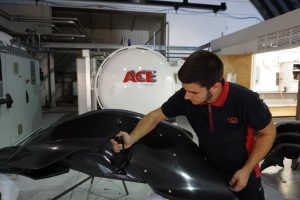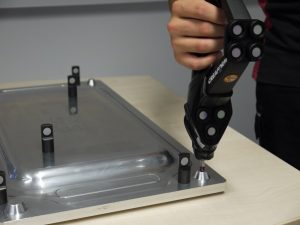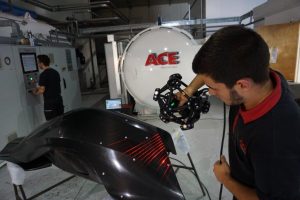July 24, 2024
Improving Vessel Integrity at a Refinery thanks to Advanced 3D Scanning Technology See the articleACE Technology was founded in 2004 in the UK, with a mission to offer best-in-class composite material manufacturing services. The first industry it served was motorsports, a demanding sector that requires both a quick time-to-market as well as unprecedented flexibility in handling several design changes during the entire manufacturing process.
Edging out the Competition
Right from the beginning, ACE Technology understood the importance of being distinctive to maintain its leadership position in a very competitive market. Its approach was to offer its customers complete solutions, by better extending its capabilities
ACE Technology is a Full-service Supplier (FSS) that offers a breadth of expertise—from the design process to the manufacturing of products (including pattern and mold tools, jigs, fixtures, etc.) as well as quality control. The company additionally operates four autoclaves and prides itself in developing high-end composite components.
Diversification
Over the years, ACE Technology had to adapt to variations in customer demand, which is a reality for many engineering companies. 2009 was a more difficult year, with the economic crisis prompting major OEMs to pull out of participating in the British Touring Car Championship.
Thankfully, thanks to its diversified service portfolio, Ace Technology was soon able to obtain contracts in new industries, such as aerospace, defense, and communications.
The Need for Metrology Tools
In 2009, ACE Technology won a major contract that involved the manufacturing technology for satellite reflectors. This contract, which required high-accuracy measurements as well as specific RMS value measurements, drove the company to purchase its first piece of advanced metrology equipment: a portable measuring arm. As ACE’s Director Paul Skinner explained: “At the time, it was the only portable solution available as an alternative to a fixed and expensive CMM.”
ACE integrated advanced metrology as part of their core business across various industries it served. The company also added 3D laser scanning, since it was looking to expand its services to the early stages of the design process.
Engineering an Entire Car
For a specific project, ACE Technology was mandated to entirely ‘composite engineer’ an LMP sports racing car. The company had to build its expertise in geometric optimization of composite material as well as address both stringent mass targets and crash testing requirements.
As Paul Skinner explained, geometry optimization first involved digitizing the existing part, shape or object and worked from this 3D copy to improve the design. “It was during such applications that we realized the portable arm solution is really not so portable.”
According to the director, as part of the scope of the project, the company was often required to travel across the UK to visit customer facilities. “Immediately, a large heavy tripod became both a logistical and health and safety concern. In addition, mounting an arm inside a vehicle presented two different problems: access and movement. While the vehicle moved as we entered it, any datum sets were immediately lost, unfortunately making all subsequent data useless.”
3D Optical Scanning Comes into Play
Mr. Skinner put Edward Smith, an engineering intern at ACE, in charge of researching 3D scanning and other new portable technologies. The company needs were clear: it required a truly portable device that could scan various surfaces (such as carbon fiber, epoxy, virtual mirrors, polished aluminum) and included software, both simple to use.
After a few experimentations, Mr. Smith realized that the two major portable arms on the market had the same limitations: they were still too difficult to move around and operate around an object.
Mr. Smith then considered an optical solution, the Creaform MetraSCAN 3D and HandyPROBE, which quickly proved to resolve all the issues previously experienced with measuring arms. Mr. Smith had already used an earlier MetraSCAN 3D version at a previous company, which made him familiar with the benefits of Creaform products. “These solutions had superior scan speed, maneuverability, and consistent accuracy,” he noted, adding that the latest developments of the device resulted in exceptional scan quality even with mirror-like surfaces and carbon parts.
Mr. Skinner was very impressed, saying that he “simply couldn’t believe how this system was 2 to 3 times faster than anything else seen in the market!”
The Creaform Solution
ACE Technology turned to Measurement Solutions (MSL), the official Creaform distributor for the UK, and purchased a 3D scanning system comprising a MetraSCAN 3D, a HandyPROBE as well as the VXelements software.
According to Mr. Smith, with the guidance of MSL, the ease-of-use of this system quickly became a major selling point for the company. “Our core business is product design and manufacturing. We didn’t want to dedicate a specialist to this equipment. Therefore, we were seeking a product with a relatively friendly learning curve so that several technicians could pick up and use intermittently, sometimes weeks apart,” he stated.
VXelements was also perfectly suited for this type of workflow and greatly simplified the team’s tasks. Previously, during a reverse engineering process, data was exported into a SolidWorks plug-in or other complex third-party software. Now, live transfers make it possible to directly view the surface-ready data and section cuts in SolidWorks.
 |
 |
No Measuring Arm Needed!
In the past, designing and manufacturing mold tools and fixtures typically required tactile measurements of datum tooling holes and key critical feature measurements. However, the Creaform solution replaced this cumbersome equipment seamlessly: just like a measuring arm, the handheld and wireless HandyPROBE enables sophisticated probing. Both the HandyPROBE and MetraSCAN 3D work in synergy with the C-Track, an optical camera system that provides 6 degrees of freedom over a volume of 16 m3. The HandyPROBE dynamically reports a Cartesian co-ordinate of a component or tool datum, which can then be used to build tools and set nominal positions or report surface deviations to a CAD file.
In both the aerospace industry and with F1 tooling, it is common practice to have either a portable arm and a laser tracker or a laser tracker featuring a handheld probing and scanning solution. However, both these situations significantly prevent possible movements around the measurement area. The process is both complex and error-prone. Nevertheless, the C-Track solution greatly simplifies it by automatically and dynamically realigning the area with its optical cameras, thereby drastically reducing measuring time.
What’s Next?
Today, ACE Technology operates two factories in Cambridgeshire, England, and employs a workforce of about 50 skilled professionals.
The company is now looking to further grow its presence in the aerospace industry, currently finalizing a new supplier accreditation and compliance. Moreover, ACE purchased a high-end Markforged 3D printer, making it possible to offer fiber-reinforced nylon tooling and components.
According to Mr. Skinner, the MetraSCAN 3D plays a vital role in the adoption of 3D printing “by capturing data from patterns, tooling or final parts that can be quickly converted into files suitable for 3D printing.” 3D scanning technology can further be used to develop 3D-printed jigs, templates, and fixtures, making it possible to shorten the time required when developing various composite production processes.”
Mr. Skinner concluded that as a portable scanner, “the MetraSCAN 3D is a key investment to support our SCAN to CAD initiative. We are confident that it will play a vital role in our future expansion.”








